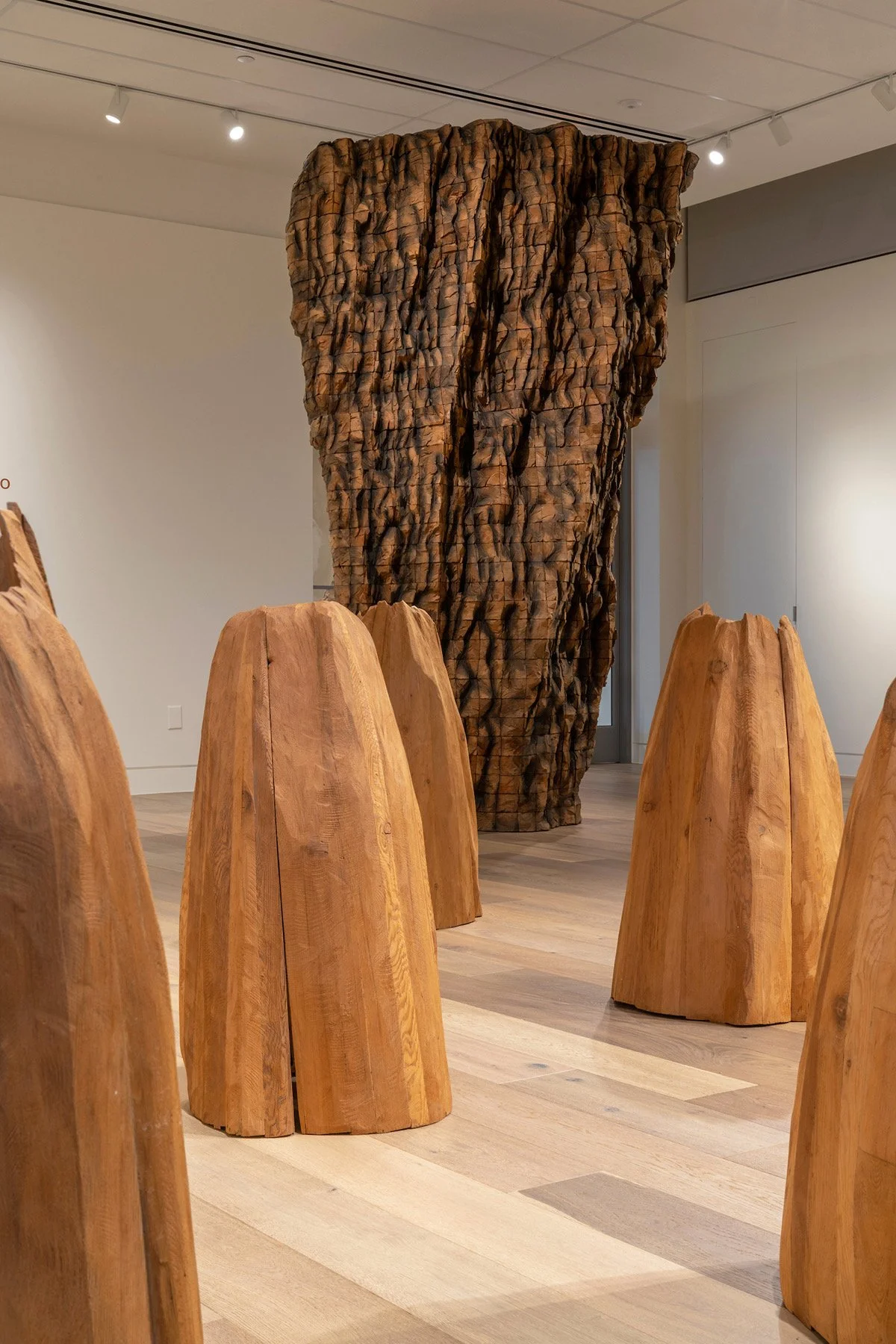Zoid Room: The Black Dreamscape
J. Benjamin Burney: Zoid Room: The Black Dreamscape
The Storeroom
1700 Vine Street, Denver, CO 80206
June 10-August 13, 2022
Admission: Free
Review by Livy Snyder
Appealing to our curiosity, dreams, and affirmations of resilience, J. Benjamin Burney’s exhibition Zoid Room: The Black Dreamscape is an immersive installation suffused with emotion that reorients our perceptions of the world. The exhibit is now on view at The Storeroom in the Capitol Hill neighborhood of Denver through August 13.
A view of J. Benjamin Burney’s exhibition Zoid Room: The Black Dreamscape at night. Image courtesy of the artist.
Zoid Room: The Black Dreamscape offers a poetic encounter between the passersby walking down Vine Street and the storefront window turned gallery. Peering through the window, it is apparent that Burney has utilized the full potential of the space: the artist has addressed and filled every crevice and corner with thoughtful work. The eye is pulled from one medium to another in the immersive installation, which includes furniture, clothing, collage, paintings on canvas, and photography, and features iconography, symbols, and stories of the Black American experience.
A view of Zoid Room: The Black Dreamscape featuring paintings and collages, including in the center Hold Fast To Dreams (#2), 2022, mixed media collage, 32 x 48 inches, and in the foreground the sculptures Plymouth Rock, 2022, Styrofoam and acrylic, and Sit-In Bench, 2022, acrylic and marker on found bench. Image by Jasmine Williams.
J. Benjamin Burney, Hold Fast To Dreams (#3), 2022, mixed media collage, 32 x 48 inches. Image courtesy of the artist.
At the edge of the windows facing the street, an assortment of Jet magazines, dolls such as the Christie Barbie, and sports action figures like Terrell Davis line the sill. Each wall of the gallery is painted in the colors blue, red, yellow, and green with hand-written affirmations like “We Still Here” in bold letters. On the blue and yellow walls is a mixed media series, Hold Fast To Dreams—a title drawn from a poem by Langston Hughes. This series assembles the faces of significant Black Americans: historical figures, popular icons, and even victims of police brutality (like Breonna Taylor). Burney uses a style that evokes the works of Romare Bearden and Deborah Roberts—artists who create a broad dialogue engaging American history, Black culture, and popular culture by collaging found imagery from magazines and photographic clippings.
J. Benjamin Burney, 4 Nipsey, 2021, acrylic paint and iron-on paper collage on upcycled blue flannel shirt. Image by DARIA.
J. Benjamin Burney, Trap Baby Statue, 2022, plastic, clay, spray paint, and chain, 7 x 2 x 2 feet. Image by DARIA.
Other mixed media pieces include a hanging plaid shirt with a photographic portrait of the rapper Nipsey Hussle (1985-2019) printed across the back; a sculpture titled Trap Baby Statue that combines a black fist statue—which is a depiction of the popular American folktale Brer Rabbit and the Tar Baby—and a mannequin with a chain hanging over its shoulders; and Sit-In, a piece where Burney invites viewers to sit on a bench on which he has transcribed Dr. Martin Luther King Jr.’s speech “I Have A Dream.”
A view of J. Benjamin Burney’s exhibit Zoid Room: The Black Dreamscape with Sit-In Bench, 2022, acrylic and marker on found bench in the foreground. Image by DARIA.
While the exhibition title suggests a dreamscape or a surreal state, this dream is built from the past. Burney points not only to historical figures and icons in popular culture, but also looks at the history of The Storeroom itself. The gallery is located in an area where, historically, African Americans were not allowed to reside due to racist real estate practices in Colorado. [1] As a result of this exhibition, Burney states that the area where we find “the Zoid Room becomes a space that allows for history to be acknowledged and rewritten by your presence, and that to me is an interactive experience that carries weight not only in the waking world, but also in the collective dream of America.” [2]
J. Benjamin Burney, ZOIDPHOTOS, 2022, digital photo collage. Image by DARIA.
As the sociologist Ruha Benjamin once reflected, “…imagine and craft the worlds you cannot live without, just as you dismantle the ones you cannot live within.” [3] J. Benjamin Burney’s exhibit is a collaborative gesture which introduces viewers, by way of immersive installation, into another dimension of dreaming. It unravels and reimagines Eurocentric, colonial narratives that have dominated the past, conjuring a liberatory world not quite here yet but still within our grasp.
Livy Onalee Snyder holds a Masters in Humanities from the University of Chicago. Currently, she serves as board president of Denver Digerati and works for punctum books advocating for Open Access.
[1] B. Erin Cole, “Race, Sexuality and Single-Family Zoning in Denver's Park Hill and Capitol Hill Neighborhoods, 1956-1989,” PhD diss, University of New Mexico, 2014: https://digitalrepository.unm.edu/hist_etds/14/?utm_source=digitalrepository.unm.edu%2Fhist_etds%2F14&utm_medium=PDF&utm_campaign=PDFCoverPages.
[2] Interview between the author and Benjamin Burney via email on July 18, 2022.
[3] Ruja Benjamin, Captivating Technology: race, carceral technoscience, and liberatory imagination in everyday life, (Durham and London: Duke University Press, 2019): 14.














